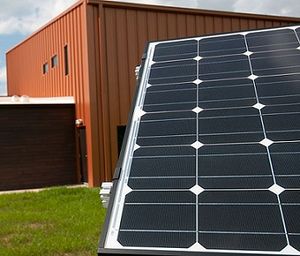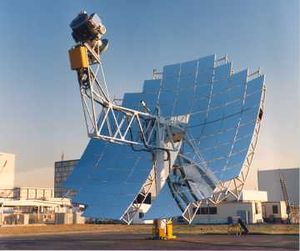Solar power
Solar power is the electricity generated using the solar radiation from the Sun.Currently, solar power supplies about 1% of electricity used every year in the world.[2] However, there are some countries that use greater amounts of solar power. Italy, Germany, and Belgium are three countries which obtain the greatest percentage of their electricity from solar energy.[3] See the data visualization below for more statistics on solar power in the world.
The ability to harness sunlight and use that energy to generate electricity is achieved by the use of a variety of solar collectors. Primarily, the use of photovoltaic cells are necessary. These photovoltaic cells make use of a semiconducting material that, when struck by sunlight, generates a small current as a result of the photovoltaic effect. Unlike some power plants that require steam, solar power using photovoltaic cells is created directly by transforming energy from the Sun into electricity. However, this is not the case with solar thermal power. In this case, solar collectors are used to focus the Suns energy on some heat transfer fluid, which is then used to heat water to steam and turn a turbine. This generates electricity. Figures 2 and 3 below show a solar power plant and a solar thermal power plant.
- Solar Power Plants
Figure 2. A photovoltaic array.[4]
Figure 3. Two solar power towers at a solar thermal power plant.[5]
There are numerous solar farms worldwide, and the size and capabilities of these farms has increased dramatically over the years. The largest of these solar farms is the Olmedilla Photovoltaic Park in Spain. This farm uses 162 000 flat solar panels and can provide 60 megawatts of electricity on a sunny day. However, this plant was very expensive to create as the panels were built with silicon. The cost of the project was estimated at $530 million.[6]
Collection Methods
In order to use the energy from the Sun to generate electricity, there needs to be some method of "catching" this solar radiation. Since there is no fuel to burn to generate electricity like there is in fossil fuel power plants or nuclear power plants, different methods are used to capture or concentrate sunlight. There are two main methods: photovoltaic cells and solar collectors. While solar collectors are less expensive as they are composed of only mirrors, photovoltaic cells can be more useful as they directly transform solar radiation into electricity.
Photovoltaic Cells

A photovoltaic cell is an energy harvesting technology used to directly convert solar energy into electricity. The vast majority are composed of silicon semiconductors, and interact with incoming photons in order to generate an electric current.[8]
These cells can be placed in a solar panel and oriented to face the Sun. For residential use, generally only a few panels on the roof are needed to generate enough electricity for the home. For large scale electricity generation on solar farms, large numbers of these panels are arranged in an array (shown in Figure 2) to collect enough sunlight to generate a significant amount of electricity.
For more information on the different types of photovoltaic cells, click here.
Solar Collectors

Solar collectors are a series of devices that transform solar radiation into heat, which is then transferred into a heat transfer fluid. These devices are used primarily for active solar heating and allow for the heating of water for personal use.[10] These collectors are generally mounted on the roof and must be very sturdy as they are exposed to a variety of different weather conditions.[10]
There are several different types of collectors, but most collect and concentrate energy from the Sun using a dark coloured absorbing coating or mirrors. They then transfer this energy to some fluid which eventually heats water to produce steam, which is used to turn turbines and create electricity.
Interactive Graph
The line graph below shows rapid growth in consumption of solar energy in different regions worldwide. Another useful view is to select "bar" and "country", to see the major solar power users worldwide. Once here, clicking the "per capita" button will show the solar power per person.
References
- ↑ Pixabay. (August 19, 2015). Sunlight [Online]. Available: http://pixabay.com/en/sunlight-sky-daylight-summer-422710/
- ↑ IEA. (August 19, 2015). World Energy Balances [Online]. Available: http://dx.doi.org.ezproxy.lib.ucalgary.ca/10.1787/data-00512-en
- ↑ Zachary Shahan. (August 19, 2015). Top Solar Power Countries [Online]. Available: http://cleantechnica.com/2012/06/12/top-solar-power-countries-per-capita-per-gdp-per-twh-of-electricity-produced-in-total/2/
- ↑ Wikimedia Commons. (August 19, 2015). Giant Photovoltaic Array [Online]. Available: https://upload.wikimedia.org/wikipedia/commons/thumb/4/45/Giant_photovoltaic_array.jpg/640px-Giant_photovoltaic_array.jpg
- ↑ Wikimedia Commons. (August 19, 2015). PS20 and PS10 [Online]. Available: https://upload.wikimedia.org/wikipedia/commons/2/22/PS20andPS10.jpg
- ↑ Solar Insure. (August 19, 2015). Top 5 Largest Solar Plants [Online]. Available: http://www.solarinsure.com/largest-solar-power-plants
- ↑ "20110504-RD-LSC-0621 - Flickr - USDAgov" by U.S. Department of Agriculture. Licensed under CC BY 2.0 via Wikimedia Commons - http://commons.wikimedia.org/wiki/File:20110504-RD-LSC-0621_-_Flickr_-_USDAgov.jpg#/media/File:20110504-RD-LSC-0621_-_Flickr_-_USDAgov.jpg
- ↑ R. Wolfson. Energy, Environment, and Climate, 2nd ed., New York, NY: W.W. Norton & Company, 2012
- ↑ Wikimedia Commons. (August 10, 2015). Solar Stirling Engine [Online]. Available: https://upload.wikimedia.org/wikipedia/commons/5/59/SolarStirlingEngine.jpg
- ↑ 10.0 10.1 G. Boyle. Renewable Energy: Power for a Sustainable Future, 2nd ed. Oxford, UK: Oxford University Press, 2004.




